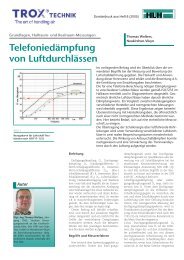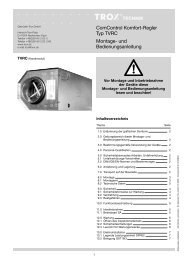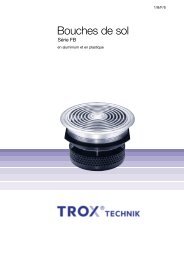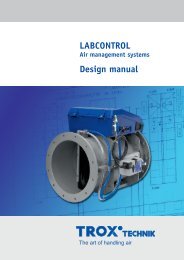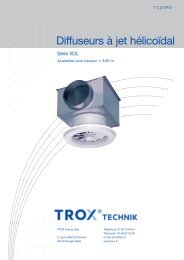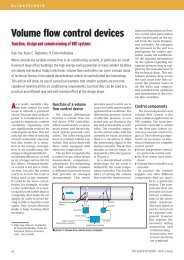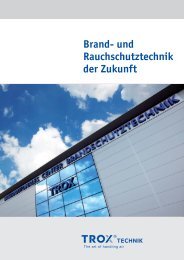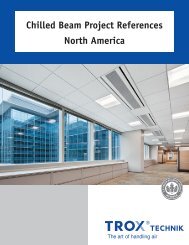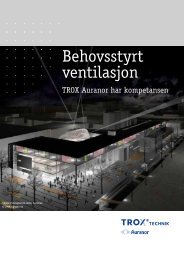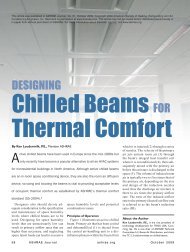You also want an ePaper? Increase the reach of your titles
YUMPU automatically turns print PDFs into web optimized ePapers that Google loves.
Multi-Service <strong>Chilled</strong> <strong>Beam</strong>s<br />
Multi-service <strong>Chilled</strong> <strong>Beam</strong> <strong>Design</strong>s<br />
Figures 13 and 14 below illustrate passive and active<br />
multi-service beam installations.<br />
Note that the photograph in figure 13 includes a swirl<br />
type diffuser mounted in the floor near the window. This<br />
diffuser supplies conditioned air for the ventilation and<br />
dehumidification of the space. The beams include a<br />
linear bar grille for the room air discharge and are<br />
curved to conform to the curvature of the ceiling. Both<br />
direct and indirect lighting is provided.<br />
Figure 14 illustrates an active beam version where the<br />
facial slots have been relocated such that they are not<br />
visible and are integrated into the top of the beam, discharging<br />
supply air across the surface of the exposed<br />
slab. Again lighting is both direct and indirect in the<br />
case of these beams.<br />
The photographs in these figures do not show a services<br />
corridor that runs perpendicular to the beams toward<br />
the interior of the space. This corridor is approximately<br />
the depth of the beams themselves and houses<br />
the main ductwork, piping and other services that feed<br />
the beams. These corridors may also house the return<br />
air passage in case where the slab is exposed. As a<br />
rule of thumb, about thirty (30) linear feet of beams may<br />
be connected to each run leaving the service corridor.<br />
Most multi-service beams are provided for exposed slab<br />
applications but other versions can be provided to integrate<br />
with acoustical ceiling grids.<br />
The Case for Multi-service <strong>Beam</strong>s<br />
Multi-service chilled beams offer numerous advantages<br />
over conventional service delivery systems, notably:<br />
1. As the services are integrated into the beams in the<br />
factory, quality control can be much better maintained<br />
than with field mounted services. Factory<br />
mounting involves the provision of proper fixtures<br />
to do the work and facilitates difficult piping and<br />
valve connection. This also allows the final piping<br />
to be leak tested after the components are assembled.<br />
2. Factory mounting of the space services reduces<br />
the amount of required trade coordination on the<br />
job site.<br />
3. All of the space services mounted in the common<br />
housing can be easily accessed for final connection<br />
and commissioning as well as future maintenance.<br />
4. The design of the housing involves the project architects<br />
as well as the engineering consultants and<br />
drives early coordination efforts as opposed to last<br />
minute panics.<br />
5. The above advantages can result in significant<br />
reductions in the time required to construct the<br />
building.<br />
The construction time reduction has made multi-service<br />
beams very popular in the Europe, especially the United<br />
Kingdom. Cases where the building construction time<br />
has been reduced by 25 to 30 percent have been well<br />
documented in a number of publications. Construction<br />
schedule reductions of ten to fifteen percent result in<br />
Figure 13: Passive Multi-service <strong>Beam</strong>s<br />
Figure 14: Active Multi-service <strong>Beam</strong>s<br />
12





